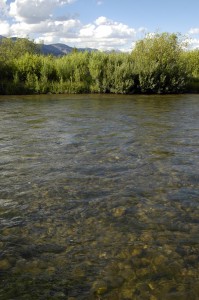02
Nov
Court Upholds Protection for Salmon Protections
(Beyond Pesticides, November 2, 2011) On Monday, a federal judge rejected a lawsuit brought by Dow AgroSciences challenging pesticide application restrictions to protect salmon and upheld the measures recommended by the National Marine Fisheries Service (NMFS) to protect endangered salmon and steelhead from three highly toxic pesticides: chlorpyrifos, diazinon, and malathion.
The restrictions, recommended by NMFS’s Biological Opinion in 2008, ban the ground spraying of the three commonly used organophosphate agricultural insecticides within 500 feet of any salmon-bearing waterway, and aerial spraying within 1,000 feet. NMFS has issued four Biological Opinions, the latest on June 2011, which call for several limitations on aerial spraying and ground application of the pesticides near salmon waters, as well as buffer zones around salmon waters and ditches that drain to salmon habitat, among others. EPA was court ordered to consult with NMFS to identify measures needed to protect salmon and steelhead from the pesticides as a result of a 2002 and 2007 lawsuit. Pesticide manufacturers have been willfully ignoring and challenging NMFS’s findings. Dow AgroSciences alleged that NMFS used bad data and modeling and that the proposed buffers are far too large. Earthjustice, representing Northwest Center for Alternatives to Pesticides (NCAP), Pacific Coast Federation of Fishermen’s Associations, and Defenders of Wildlife, intervened in the case to defend important safeguards for west coast salmon and the fisheries jobs they support.
According to NCAP, the court’s ruling, issued by Judge Alexander Williams, Jr. of the U.S. District Court for the District of Maryland, turns back industry’s efforts to undermine no-spray buffer zones and other measures required to protect imperiled salmon from exposure to the organophosphate pesticides chlorpyrifos, diazinon, and malathion. These pesticides are known to contaminate waterways throughout California and the Pacific Northwest.
“The Court’s decision is a victory for everyone’s health,” said Aimee Code with the Northwest Center for Alternatives to Pesticides. “It foiled the pesticide industry’s attempt to evade the laws that protect both people and wildlife.”
The case stems from a lawsuit originally filed by conservation and fishing groups represented by Earthjustice in 2001. In response to that litigation, the fishery experts at NMFS evaluated these pesticides and determined that no-spray buffer zones next to streams and vegetated strips to catch pesticide-laden runoff from fields are needed to protect salmon. The U.S. Environmental Protection Agency (EPA) was tasked with implementation of the pesticide restrictions. However, to date, EPA has still not taken any actions to implement any of these measures. In a May 14, 2010 letter to NMFS, EPA explained how the agency planned to achieve protection goals through the methods outlined by NMFS in the Biological Opinions or by alternative methods that EPA’s scientific analyses determined will achieve the same purpose. At the same time, in an act of defiance, Dow AgroSciences and Cheminova, manufacturers of the pesticides in question, stated in correspondence to the EPA dated May 7, 2010, that they were “baffled by the agency’s position,” saying that their products do not threaten endangered species. Citing their “solid scientific evidence,” that they claim is “far more complete than is reflected in the NMFS Biological Opinion,” they are not prepared to make the registration revisions [to their products] described in the EPA’s April 29, 2010 and November 2009 requests.
Also in 2010, a lawsuit was filed in U.S. District Court in Washington as the fourth lawsuit brought against the EPA to restrict the pesticides diazinon, malathion, chlorpyrifos, carbaryl, carbofuran and methomyl in streams of endangered salmon and steelhead. The plaintiffs sought a judgment declaring that EPA’s failure to implement the organophosphate (OP) and carbamate biological opinions issued by the NMFS violates the Endangered Species Act (ESA), and a judgment declaring that EPA is taking listed salmonids in violation of the ESA. The lawsuit sought an order vacating and enjoining EPA’s authorization of the uses of diazinon, malathion, chlorpyrifos, carbaryl, carbofuran, and methomyl that do not comply with the recommended mitigation measures until such time as EPA has put in place permanent measures that ensure against likely jeopardy to listed salmon and steelhead or adverse modification of their critical habitat, and an order compelling EPA to put in place such permanent measures within one year.
In a similar issue, a NMFS draft Biological Opinion found that the issuance of the proposed pesticides general permit by EPA is likely to jeopardize the continued existence of endangered and threatened species and cause the destruction or modification of critical habitat of the species without the implementation of a reasonable and prudent alternative (RPA). NMFS stated that pesticide discharges were resulting in exposures to pesticide pollutants in concentrations, durations or frequencies that would cause adverse effects to ESA listed species or designated critical habitat. The controversial pesticide general permit went into effect October 31, 2011 after months long battle in Congress to have the water protections revoked.
The pesticides that have been reviewed so far are some of the most dangerous chemicals used today. Chlorpyrifos, diazinon, malathion, carbaryl, carbofuran, and methomyl are neurotoxic and pose serious risks to both humans and wildlife. While many of these pesticides have been phased out for residential use, they continue to expose wildlife and farmworkers through their use in agriculture. Studies have shown that mixtures of organophosphate and carbamate pesticides cause more harm to endangered salmon than individual pesticide exposure and are commonly detected in freshwater habitats that support these threatened and endangered species.
Source: NCAP
All unattributed positions and opinions in this piece are those of Beyond Pesticides










